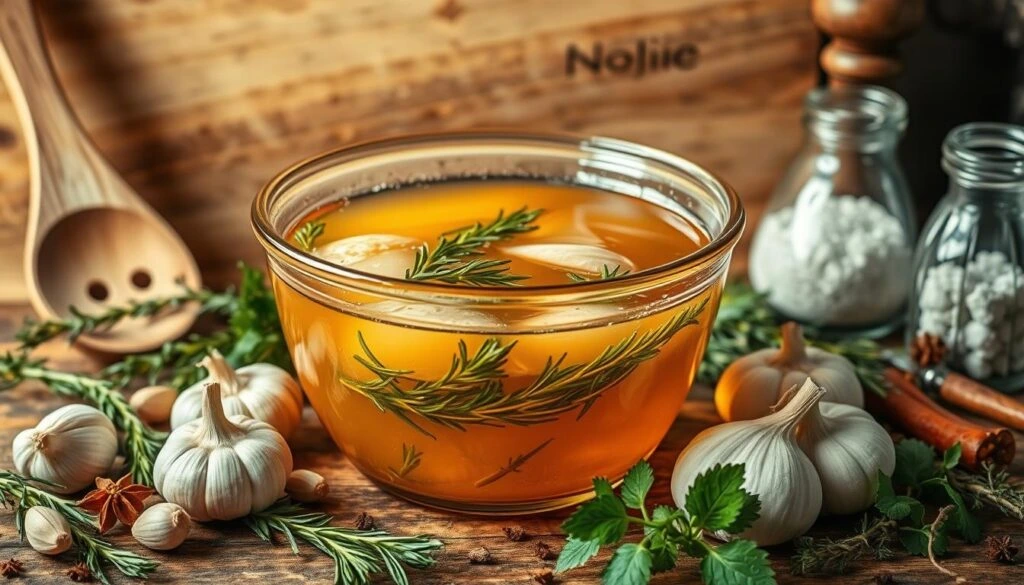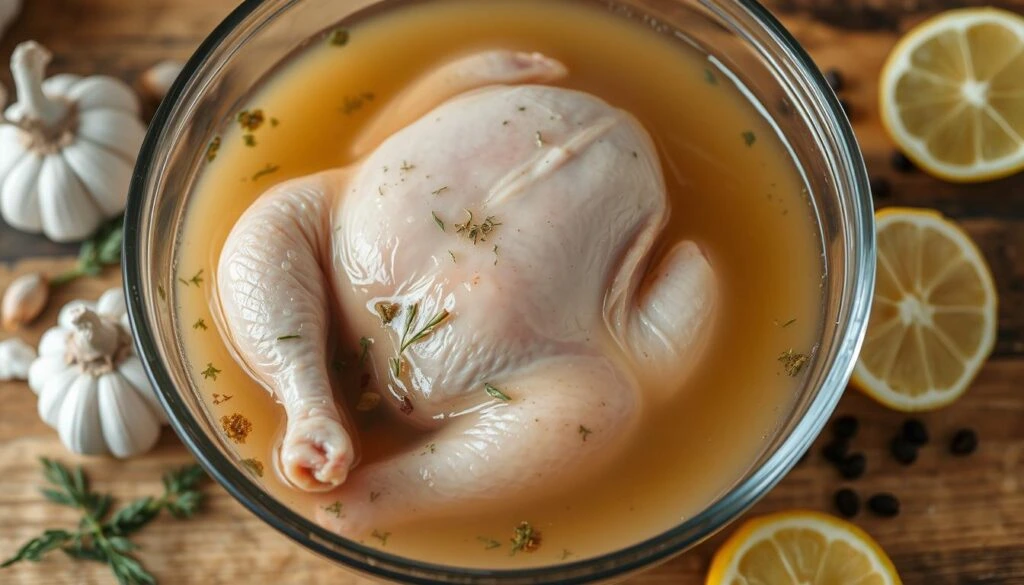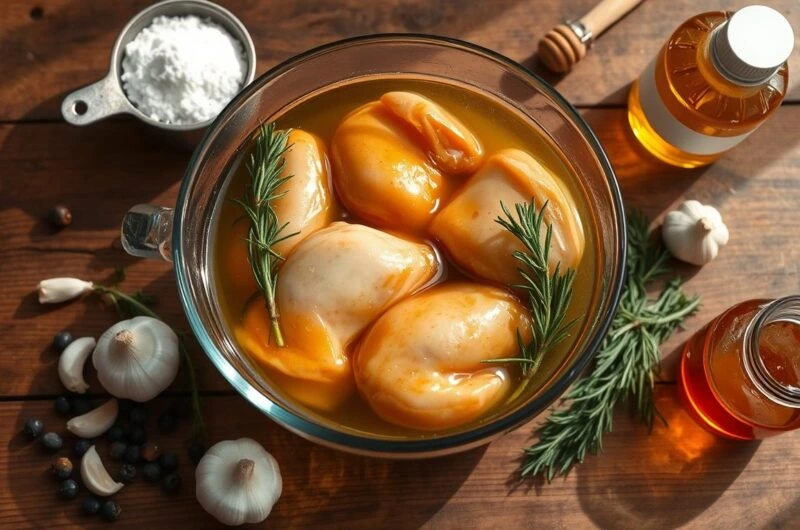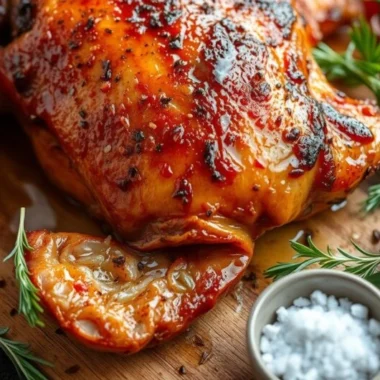I’ve always been curious about brining. It’s a way to make chicken taste amazing. I found a chicken brine recipe that changed how I cook chicken. It makes chicken juicy, tender, and full of flavor.
Table of Contents
What is Chicken Brine and Why Use It?
Chicken brine is a simple yet powerful cooking method. It involves soaking chicken in a saltwater solution before cooking. This makes the meat more moist, tender, and flavorful. It’s great for making Brining Recipes for Moist Chicken or using a Meat Tenderizer.
Understanding the Basics of Brining
Brining means soaking meat, like chicken, in a saltwater solution. This solution often includes sugar, herbs, and spices. The salt breaks down the meat’s protein, keeping it moist during cooking.
This makes the chicken juicier, more tender, and tastier than unbrined chicken.
Benefits of Brining Chicken
- Increased Moisture Retention: Brining can make chicken up to 40% juicier.
- Improved Texture: The salt tenderizes the chicken, making it softer and more enjoyable.
- Enhanced Flavor: The brine solution adds a subtle, seasoned flavor to the meat.
Common Ingredients in Chicken Brine
While basic brine has salt and water, many add extra ingredients. These can include:
- Salt: The main ingredient that tenderizes and seasons the chicken.
- Sugar: Adds a touch of sweetness and balances the brine’s saltiness.
- Aromatics: Garlic, onions, herbs, and spices add complex flavors.
- Citrus: Lemon or orange juice adds a tangy, refreshing note.
“Brining is the secret to the most tender, juicy, and flavorful chicken you’ll ever taste. It’s a game-changer in the kitchen.”
Essential Ingredients for a Perfect Chicken Brine
Making a tasty chicken brine needs the right ingredients. At its core is salt. You can pick from Diamond Crystal kosher salt, Morton’s kosher salt, or fine table salt. The amount of salt you use affects the brine’s flavor on your chicken.
Salt: The Star of the Brine
Salt is key for making the chicken juicy and tender. The type and amount of salt you choose changes the flavor. Use about 1/2 cup of kosher salt for every gallon of water in your Brine Solution.
Sugar and Its Role in Flavor
A bit of sugar can enhance your Chicken Seasoning. Add 2-3 tablespoons of sugar per gallon of water. This adds a sweet touch that complements the savory brine flavors.
Aromatics to Enhance the Brine
- Garlic powder
- Onion powder
- Fresh herbs (such as rosemary, thyme, or sage)
Adding aromatics like garlic powder, onion powder, and fresh herbs can make your Brine Solution even better. They add a rich flavor to your chicken. Try different mixes to find what you like best.
For a great chicken brine, balance is key. Mix salt, sugar, and aromatic flavors right. With some trial and error, you’ll get juicy, flavorful chicken that everyone will love.
Step-by-Step Guide to Making Chicken Brine
Brining chicken is a simple yet effective Culinary Technique that can transform your poultry into a tender, flavorful masterpiece. By immersing the chicken in a savory Brine Solution, you can unlock a world of mouthwatering possibilities. Let’s dive into the step-by-step process of creating the perfect chicken brine.
Measuring Your Ingredients
The foundation of a great chicken brine starts with the right measurements. For a 4-5 pound roasting chicken, you’ll need:
- 1 gallon of cool or room temperature water
- 3/4 cup of coarse kosher salt
- 2/3 cup of granulated sugar
- 3 dried bay leaves
- 5 cloves of garlic, peeled and lightly crushed
- 1 tablespoon of whole black peppercorns
- 3 sprigs of fresh rosemary
- 3 sprigs of fresh thyme
- 3 sliced lemons
Mixing the Brine Solution
In a large non-reactive container, such as a deep bowl or a brining bag, combine the salt and water, stirring until the salt is fully dissolved. For enhanced flavor, blend the fresh herbs, uncooked aromatics, salt, and some of the water in a blender or food processor, then add the mixture to the remaining water. This creates an aromatic, flavorful brine without the need for boiling.
Cooling the Brine
Once the brine is mixed, it’s essential to cool it to room temperature before adding the chicken. This can be achieved by placing the container in the refrigerator for at least an hour or by adding ice cubes to the brine. Ensuring the brine is cool helps prevent bacterial growth and creates the ideal environment for the chicken to soak up all the delicious flavors.

With your ingredients measured, the brine mixed, and the solution cooled, you’re now ready to submerge your chicken and let the magic of brining work its wonders. Stay tuned for the next steps in the perfect chicken brining process!
How Long to Brine Chicken for Best Results?
Brining makes chicken juicy and flavorful. The brining time greatly affects the chicken’s texture and taste. Knowing the right brining time for each cut is essential for great results.
Brining Time for Various Cuts
The brining times differ for each chicken cut:
- Whole chicken: 8–12 hours
- Chicken breasts: 1–2 hours
- Thighs/drumsticks: 2–4 hours
- Wings: 1–2 hours
The best brining time is usually 4-6 hours. This ensures the chicken is seasoned well and tender, without being too salty.
Signs Your Chicken is Perfectly Brined
Here are signs your chicken is perfectly brined:
- Well-seasoned Flavor: The meat is flavorful all the way through, not just on the outside.
- Noticeably More Tender and Juicy: Brining keeps the chicken moist, making it tender and juicy.
Watching for these signs helps you know when your chicken is perfectly brined. This ensures a Juicy Chicken experience.
“Brining is the secret to the most tender and juicy chicken you’ll ever taste. It’s a game-changer for your Brining Recipes.”
Tips for Brining Chicken Safely
Brining chicken adds flavor and keeps it moist. But, it’s important to do it safely. Here are some tips to make sure your brined chicken is both safe and tasty.
Importance of Refrigeration
Keeping chicken brine in the fridge is key. Bacteria grow fast in brine, so refrigeration is a must. Use safe containers like stainless steel or food-grade plastic for the Chicken Brine.
Avoiding Cross-Contamination
Preventing cross-contamination is also vital. Keep raw chicken away from other foods. Clean all surfaces and tools that touch raw poultry well. This stops harmful bacteria like Salmonella and E. coli from spreading, keeping Food Safety in check.
By following these tips, you can enjoy brined chicken safely. Remember, careful preparation means everyone can enjoy the delicious results.
Creative Variations on Basic Chicken Brine
Want to make your chicken dishes even better? Try adding different flavors to your brine. You can use herbs, citrus, or spices to make your chicken taste amazing.
Herb-Infused Brines
Add fresh herbs like parsley, rosemary, or thyme to your brine. They give your chicken a savory taste and look great too.
Citrus-Based Brines
For a fresh twist, use citrus in your brine. Lemon, lime, or orange zest and juice add a zesty flavor. They also make the meat tender and add depth to the taste.
Spicy Brines for Extra Kick
Want your chicken to be spicy? Add red pepper flakes, cayenne pepper, or hot sauce. Start with a little and add more until it’s just right.
Trying these different brine flavors can take your chicken dishes to the next level. You’ll discover new tastes and enjoy every bite.
| Brine Variation | Key Ingredients | Suggested Brining Time | Flavor Profile |
|---|---|---|---|
| Herb-Infused | Parsley, rosemary, thyme | 1-3 hours for chicken pieces, 4-12 hours for whole chicken | Savory, earthy |
| Citrus-Based | Lemon, lime, orange zest and juice | 1-3 hours for chicken pieces, 4-12 hours for whole chicken | Bright, tangy |
| Spicy | Crushed red pepper flakes, cayenne pepper, hot sauce | 1-3 hours for chicken pieces, 4-12 hours for whole chicken | Fiery, invigorating |
Remember, the secret to a great chicken brine is finding the right mix of flavors. Don’t be afraid to try new things and enjoy the delicious results!
How to Rinse and Dry Chicken After Brining
After brining your chicken, rinsing and drying it is key before cooking. Rinsing removes excess salt, preventing the dish from being too salty. Drying is vital for a crispy skin when roasting or grilling.
Importance of Rinsing
Brining adds moisture and flavor to chicken. But, it can make the surface too salty without rinsing. Rinse the chicken under cool water, gently rubbing the skin to remove brine. This step is crucial for balanced seasoning and avoiding an overly salty dish.
Techniques for Drying Chicken
After rinsing, dry the chicken well. The best way is to pat it dry with paper towels, pressing hard to soak up moisture. Or, place the chicken on a wire rack in the fridge for 30 minutes to an hour. This helps the skin dry and become crispy when roasting or grilling.
Proper rinsing and drying are essential after brining chicken. These steps ensure your chicken is moist, flavorful, and crispy. Mastering these Culinary Techniques will improve your Chicken Preparation skills.
Cooking Methods After Brining
Mastering brining your chicken is just the start. Now, it’s time to find the best ways to cook it. You might love the smoky taste of grilled chicken or the golden look of roasted chicken. The important thing is to handle your brined bird carefully.
Grilling vs. Baking: What’s Best?
Grilling brined chicken needs careful preparation. Make sure your chicken is dry before grilling. This prevents flare-ups. Use bone-in, skin-on cuts like breasts or thighs to keep the chicken moist and tasty.
Baking brined chicken works well too. Use a lower oven temperature, about 375°F (190°C). This helps prevent the chicken from getting too brown. It cooks the chicken evenly, making it juicy and flavorful.
Achieving the Perfect Roast
Roasting is a great way to show off your brined chicken. Pat the chicken dry and season the skin with oil, salt, and pepper. Roast at 400°F (200°C) for 45 minutes to an hour, until it’s 165°F (74°C) inside. Let it rest for 5-10 minutes before carving.
Don’t use brined chicken in soups or stews. The salt can make the dish too salty. Stick to cooking methods that let the chicken’s flavor shine.
Common Brining Mistakes to Avoid
Brining can make chicken juicy and flavorful. But, it’s key to avoid common mistakes for the best results. As a Brining Recipes expert, let’s look at the mistakes to avoid for your Culinary Technique projects.
Over-Brining Your Chicken
One big mistake is brining chicken too long. It might seem like more time means better flavor, but it can make the chicken too salty and mushy. Follow the recommended brining times, usually 30 minutes to 24 hours, based on the chicken’s size and thickness.
Underestimating the Cooling Process
Another important step is cooling the brine before adding the chicken. Skipping this can lead to bacterial growth, making your dish unsafe and of poor quality. Make sure to chill the brine well, either in the fridge or with ice, before adding your chicken.
By avoiding these common mistakes, you’ll make perfectly brined chicken every time. The secret to success is finding the right balance of flavors and keeping food safe during the Brining Recipes and Culinary Technique process.

Storing Leftover Brine
After brining your chicken, you might have leftover brine solution. It’s important to store it right to keep it safe and good for later use.
Best Practices for Refrigeration
Always keep leftover brine in the fridge. Move it to an airtight container like a glass jar or a plastic container with a tight lid. This stops contamination and keeps bacteria away. Don’t forget to mark the container with the date.
How Long Can Brine Last?
Stored right, leftover brine can last up to 2 weeks in the fridge. But, if it was used for raw chicken, throw it away and start fresh. Using brine that touched raw chicken can be risky and should be avoided.
| Storage Condition | Brine Shelf Life |
|---|---|
| Refrigerator (40°F or below) | Up to 2 weeks |
| Freezer (0°F or below) | 3-6 months |
When handling leftover brine solution, food safety is key. Always throw away brine that touched raw chicken. This way, your next brining project will be safe and tasty.
Final Thoughts on Brining Chicken
Brining is a flexible method that you can tailor to your liking. Try out different herbs, spices, and brining times to find your favorite flavor. The hard work in brining chicken is worth it, as it greatly improves the meat’s taste and texture.
Personalizing Your Brine Recipe
Brining lets you get creative. You can use various herbs, citrus, and spices to make a brine that shows off your taste. Whether you like a savory mix or a zesty citrus one, there’s no limit. Play with the salt and water ratio to find your ideal brine.
Encouragement to Experiment and Enjoy
Brining might add a step, but it’s worth it for the amazing chicken it makes. Dive into experimenting to create your own brine recipe. Enjoy the tender, flavorful chicken and share it with others. The more you try, the more you’ll see how brining can elevate your Chicken Brine and Flavor Enhancer dishes.
FAQ
What is chicken brine and why should I use it?
What are the main benefits of brining chicken?
What are the essential ingredients in a chicken brine?
How do I make the chicken brine solution?
How long should I brine chicken for best results?
How do I know when the chicken is perfectly brined?
What are some tips for brining chicken safely?
Can I add different flavors to the chicken brine?
What should I do after brining the chicken?
What are some common mistakes to avoid when brining chicken?
Source Links
- Quick Chicken Brine Recipe for Perfect Chicken Every Time – https://40aprons.com/quick-chicken-brine/
- Brined Fried Chicken | Secret to Perfect Fried Chicken | Life’s Ambrosia – https://www.lifesambrosia.com/summer-savory-brined-fried-chicken-recipe/
- Simple Chicken Brine For Grilling – https://www.joeshealthymeals.com/simple-chicken-brine-for-grilling/
- How To Brine Chicken Breasts – https://cookthestory.com/how-long-to-brine-chicken-breast/
- Chicken Brine Recipe – https://www.alphafoodie.com/chicken-brine-recipe/
- Chicken Brine Recipe – https://www.dinneratthezoo.com/chicken-brine-recipe/
- Simple Chicken Brine – https://www.allrecipes.com/recipe/170656/simple-chicken-brine/
- How to Brine a Chicken – Cooking Hacks – https://cookinghacks.com/how-to-brine-chicken/
- How to Brine Chicken: Our Guide to the Best Chicken Injection & Brine – https://www.heathrilesbbq.com/blogs/favorite-recipes/how-to-brine-chicken-our-guide-to-the-best-chicken-injection-brine
- How to Brine Chicken – https://www.savoryexperiments.com/how-to-brine-a-chicken/
- How to Brine Chicken Thighs and For How Long – https://cookthestory.com/how-to-brine-chicken-thighs/
- Mastering Chicken Brine Recipe: The Ultimate Guide – https://onestophalal.com/blogs/info/the-ultimate-guide-to-chicken-brine-recipe-juicy-and-flavorful
- How to Brine Chicken Breasts – https://www.killingthyme.net/how-to-brine-chicken-breasts/
- How to Brine Chicken Breast – https://snack-girl.com/snack/brining-chicken-breast/
- How to Brine Practically Any Meat – https://www.tasteofhome.com/article/this-is-everything-you-need-to-know-about-brine/?srsltid=AfmBOorcnPOul_9Fd-ORZSN_CpGjidNxw9YSlcL061wQfL5sZkX87xuc
- Chicken brine recipe: The best Recipe In 2024 – https://www.meatrecipes.net/chicken-brine-recipe/
- How to Brine Chicken – https://easychickenrecipes.com/how-to-brine-chicken/
- Beer-Brined Chicken – https://www.bettycrocker.com/recipes/beer-brined-chicken/71b6d4a3-1608-48dc-b6b1-c625cc6b3947
- Learn How to Brine Chicken Wings – https://www.thespruceeats.com/chicken-wing-brine-recipe-333854
- How to Brine Practically Any Meat – https://www.tasteofhome.com/article/this-is-everything-you-need-to-know-about-brine/?srsltid=AfmBOopd_YDCaSXFFc2OeFFgdZ5mv2LxV9xOoigZhyeA0B-62OiaHVbC
- I Asked 5 Chefs the Best Way To Cook Chicken Breasts—They All Said the Same Thing – https://www.simplyrecipes.com/best-way-to-cook-chicken-breasts-chefs-8733024
- Perfect Your Brine Turkey Recipe: Common Mistakes to Dodge! – https://www.bbqproshop.com/recipes/perfect–brine-turkey-recipe/?srsltid=AfmBOorYYnj8EQxJTCKUUUlkZh986-zayHxYp8fWfVEsWVkrO38cS6eo
- The 6 Mistakes You Make When Cooking Chicken Breasts – https://www.simplyrecipes.com/chicken-breast-mistakes-food-pro-8687735
- Chicken Brine (for a juicy roast chicken!) – The Recipe Rebel – https://www.thereciperebel.com/chicken-brine/
- Pickle Brined Chicken with Salsa Verde Recipe — One Creative Cook – https://www.onecreativecook.com/recipes/how-to-elevate-chicken-thighs-with-pickle-brine
- Easy Chicken Brine – Cooking With Claudy – https://cookingwithclaudy.com/easy-chicken-brine/
- How to Brine Practically Any Meat – https://www.tasteofhome.com/article/this-is-everything-you-need-to-know-about-brine/?srsltid=AfmBOooWecsPMSVbmAB6iZoATXTKmqMKzJ4wculXHY7fbyXLCbaa9wFH
Did You Try This Recipe ?
There are no reviews yet. Be the first one to write one.








